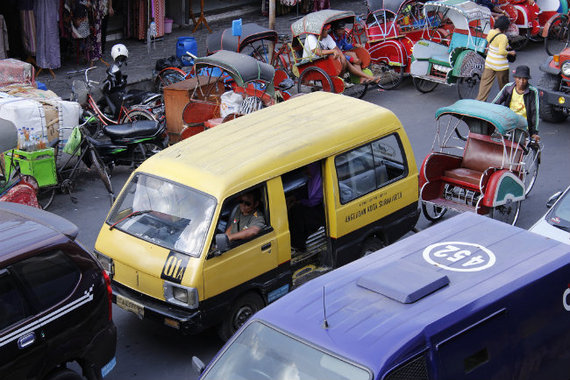British foreign secretary Arthur Balfour allegedly claimed in the early 20th century that "the motor-car will help solve the congestion of traffic." Today's city planners must not know whether to laugh or cry at this woefully misguided prediction, especially those tasked with tackling debilitating traffic in the context of burgeoning urban populations in the Global South. Faced with immense road congestion, Surabaya and Nairobi have turned to rapid mass transit solutions while Bogotá and Cairo are counting on the integration of bus and metro to relieve the prevalence of cars on the roads.
Surabaya is a center of industry and education that draws workers from its smaller neighboring cities. Currently, buses and trains lack well-integrated schedules and transit locations. Commuters view cars and motorcycles as more efficient alternatives to public transport and narrow roads further exacerbate traffic. To address these issues, the city government is developing plans for a Rapid Mass Transit system based on monorails and trams. Trams will serve multiple north-south corridors while the monorail will run east-west. Additional services will connect "park and ride" facilities to the monorail and tram hubs. In order to make transport changes legible to residents, tracking technology will identify the most efficient combination of available public transportation modes to reach a commuter's destination.
In the last three years, Bogotá has seen the number of cars on its streets increase by 35 percent. During the same period, efforts to develop a BRT system to replace old energy-inefficient buses have encountered delays and corruption. As one of only six cities with more than 4 million residents but no subway system, Bogotá may finally be on its way to building a metro. Current plans budget the project at 3 billion USD, with costs to be split between the national and municipal governments. Construction would likely take 3 to 5 years. As elected officials are limited to one four-year term, a manager appointed by Colombia's president would reduce the chance that the metro could be engulfed in political squabbles. Although reduced traffic is the goal, the actual underground construction process will create temporary turmoil on the roads above.
 In May 2014, the Kenyan government unveiled the Integrated Urban Development Masterplan for the city of Nairobi, the first update to the capital's planning documents since the 1970s. To implement the master plan, a collaboration between UN programs, the municipal government and private sector partners aims to implement three new Bus Rapid Transit corridors to decrease the cost and time of residents' commutes. Meanwhile, there may be new opportunities to make informal alternatives more efficient thanks to a number of user-driven applications and mapping projects that provide data on their routes. Until now, the dearth of reliable information on these networks has handicapped efforts to improve them.
In May 2014, the Kenyan government unveiled the Integrated Urban Development Masterplan for the city of Nairobi, the first update to the capital's planning documents since the 1970s. To implement the master plan, a collaboration between UN programs, the municipal government and private sector partners aims to implement three new Bus Rapid Transit corridors to decrease the cost and time of residents' commutes. Meanwhile, there may be new opportunities to make informal alternatives more efficient thanks to a number of user-driven applications and mapping projects that provide data on their routes. Until now, the dearth of reliable information on these networks has handicapped efforts to improve them.
Traffic congestion in Cairo costs the country over 8 billion USD annually -- nearly 4 percent of the yearly GDP. To address the city's transportation problem, the government has worked to expand and upgrade existing metro lines, taking into account opportunities to make them safer for women. In tandem, the UNDP-funded Sustainable Transport Project for Egypt has engaged public-private partnerships to develop quality bus services linking over 40 metro stations to various locations across the city as well as remote suburbs. The project began in 2009 and is due to be completed in 2015, by which point some 3 million daily metro commuters will have easier access to work. Furthermore, the buses optimize efficient energy use and the implementation process has provided considerable employment opportunities.
In each of these four cases, the municipal government seeks to prevent a potential crisis in which already overwhelming congestion exacerbates as burgeoning populations add more commuters to the clog. Whether these ambitious projects to free up the streets will effectively reduce and improve workers' commutes remains to be seen. Read more and join the conversation on URB.im.
Photo credits: Ondřej Samohel and rogiro
